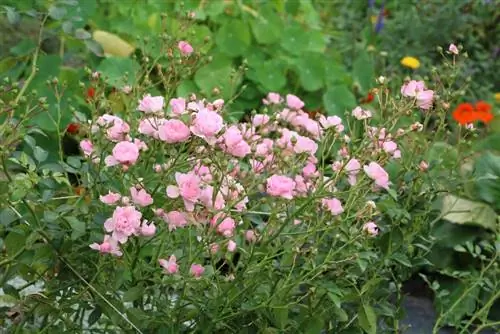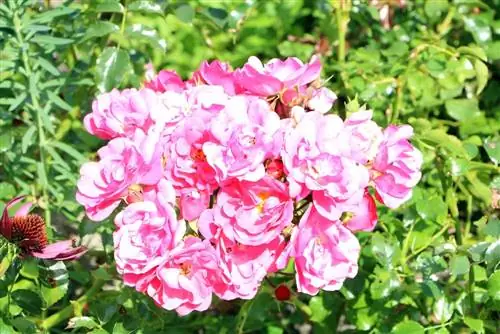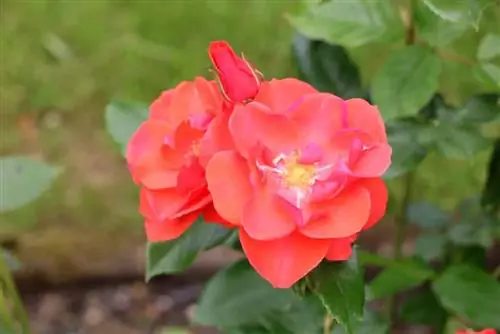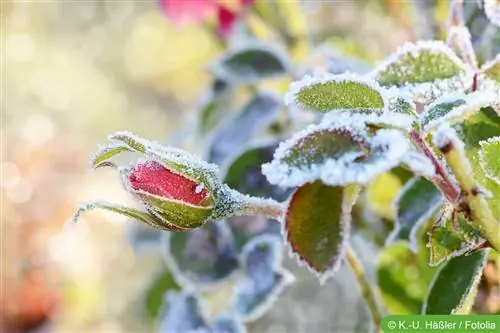- Author admin [email protected].
- Public 2023-12-17 03:39.
- Last modified 2025-01-24 12:45.
How to protect your container roses from winter and in winter:
Container roses: Preparation for overwintering begins in autumn
The container roses should first be examined thoroughly in late summer: Before they get their winter protection or move into the house, you should make sure that they have no diseases and are not infested with pests. Not only would a sick rose have difficulty surviving the winter, it could also infect the neighbors if it were planted in a room where several plants are gathered together to overwinter. So you should take precautions and, if in doubt, combat diseases and pests in good time. If this doesn't work, the potted rose can either overwinter well wrapped up in quarantine or you can decide to separate from the plant now.
Before you move or pack up the pots, you should consider whether it might be time to repot, for which now is the best time. It's not just about giving the roots enough space again, but in a larger planter the rose is also much better protected from the entire root area freezing if there is permanent frost.
The right winter protection
Depending on how strong the root system is that your container rose has already been able to form, you have to be more or less vigilant: During the last warm days of late summer, you should always be prepared for the first frosts to hit the country one night pull. Then the container roses need their winter protection immediately. Even if you spend one night unprotected outdoors, you could suffer irreparable damage.
If you can, you should give your potted roses a frost-proof place. This can be a bright basement room or shed, or an unheated greenhouse that usually heats up sufficiently in the winter sun.
If such additional rooms are not available to you, you could also give your potted roses a protected place, e.g. B. on the wall of the house, or at an angle where they get light, but at the same time are well protected from wind and weather.
You must definitely prevent the bucket from freezing completely. The rose can then no longer draw water from the earth to supply itself. So if you put the container roses in places where they could get frost for the winter, they need to be wrapped very well. So the pot gets good insulation, which you can be very imaginative when installing: If you send and/or receive a lot of packages, you probably have enough bubble wrap in the house to wrap the pot really thickly. But you can also use many other materials, e.g. B. Straw mats, jute, coconut runners and much more, in which even a large bottle of hot water stays warm for a long time if you wrap it a centimeter thick - this is a good test if you have doubts as to whether a particular material insulates well. So the pot is first packed well.
The crowns also have to be protected from direct rays of the winter sun, which would cause too much water to evaporate. They are given decorative protective covers made of special fleece or jute (never made of plastic, as they would suffocate or rot underneath). Then the whole plant must be well insulated from the ground.
If the pot is visible, you can add a little decoration if in doubt, perhaps with a wicker mat or a bark mat wrapped around the insulated container. You could even really become a designer here and use dyed or colored printed jute fabric. In this case, however, you should know for sure that only harmless colors were used. Finally, the pot can be tied up with decorative ribbons, so it looks a little like what it actually is: a gift for next spring!
However, this is not the case for your rose - it is by no means idle, but rather uses the winter to allow newly planted branches to mature and to stabilize its entire plant structure until it has to “produce” again in spring. That's why the ideal temperature for wintering is around 8 degrees. Under these conditions, the rose slows down its metabolism, but does not completely stop all cell activity.
Diet in winter

Container plants are prepared for winter with a dose of a special autumn fertilizer. This is a fertilizer that is very high in potassium, because potassium is what the plant needs during its rest period. It strengthens the cells and makes the rose resilient. Nitrogen (especially growth-promoting) and phosphorus (especially important for flowers and fruits) should only be present in trace amounts. They are only needed in very small quantities during the plant's rest period. With this fertilizer the rose will survive the whole winter.
Your container roses need regular water, even in winter. They need to be watered less than in summer! It's best to just pay attention to when the surface of the soil in the pot becomes dry, then you can water it a little again. Waterlogging would be very bad now, because fungi spread best when it is damp - so you would have to make sure that every pot is equipped with a drain and that it is also permeable.
Tips
- Any room that is bright and in which the temperature never falls below 5 degrees and never rises above 10 degrees in winter is suitable for overwintering container roses without major packaging work.
- Since packing the roses for winter can be a lot of effort, it's worth mentally going through all the rooms in the area to see if they're suitable - not necessarily just your own rooms. Maybe the neighboring sports club will be happy to make part of the rarely used storage room available to you for your potted plants if you pay a few euros into the coffee fund, and you'll have saved a lot of work.
- If there are no rooms to be found but you have neither the desire nor the time for a packaging campaign, you can also contact the nearest garden center. They will be happy to take your plants over the winter for a fee, and you will usually be delighted with how magnificent your roses look when you pick them up in spring!






